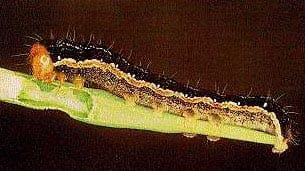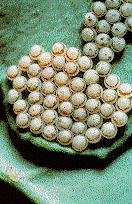
Found throughout the Prairie provinces and in parts of British Columbia, bertha armyworms are one of the most significant insect pests of canola in Canada and can be important pests of flax and quinoa. Large infestations of this pest can occur in many parts of Western Canada, but are most prevalent in parkland areas of the Prairies and in the Peace River region of British Columbia and Alberta.
Bertha armyworms (Figure 1) (Mamestra configurata) are native to North America and belong to a group of insects referred to as "climbing cutworms." Also included in this group are the true armyworm and variegated cutworm.
Life Cycle
Bertha armyworms develop through four distinct stages: adult, egg, larva and pupa. In Canada, there is one complete generation per year.
Eggs

eggs
Bertha armyworm eggs are laid in single-layered clusters of about 50 to 500 eggs on the lower surface of the host plant's leaves. The eggs are sculptured and ridged, and are the size of a pinhead (Figure 2). When first laid, they are white, but become darker as they develop. Hatching depends on accumulated heat units, but usually happens in seven days.
Larvae
Newly hatched bertha armyworm larvae are about 0.3 cm (1/10 in.) long. They are pale green, with a pale yellowish strip along each side (Figure 3). Because of their size and colour, they are difficult to see on the underside of leaves.

When disturbed, small larvae may drop off the leaves by a fine silken thread. This behaviour makes it difficult to distinguish small bertha armyworm larvae from those of the diamondback moth, which display a similar behaviour. Large larvae may drop off the plants and curl up when disturbed, a defensive behaviour typical of cutworms and armyworms.
Larvae take approximately six weeks to complete their development, depending upon temperature. During this period, they moult five times and pass through six growth stages. As they mature, their colour becomes variable. Some remain green, but many become brown or velvety black.
At maturity, the larvae are about four cm (1.5 in.) long, with a light brown head and a broad, yellowish-orange strip along each side. The velvety black larvae have three narrow, broken white lines on their backs. At maturity, in late summer or early fall, larvae burrow into the ground and form pupae, their over-wintering stage.
Host Plants and Damage
Larvae are the only developmental stage of the Bertha armyworm to cause crop damage. They feed on a variety of crops and weeds.
Canola, rapeseed, mustard, alfalfa, lamb's quarters and related plants are preferred host plants. Bertha armyworm will also feed on a range of secondary hosts, including flax, peas and potatoes.
Monitoring Larval Populations

Photo Saskatchewan Agriculture
Early detection and regular monitoring of bertha armyworm larvae are critical to minimize crop losses. Larval monitoring should begin about two weeks after peak trap catches, and continue until the number of larvae exceed economic thresholds and the crop is sprayed, or until the crop is swathed.
At each location, mark out an area one metre square and beat the plants growing within that area to dislodge the larvae. Push the plants aside or remove them and count the number of larvae in the square metre area. It is important to take your time while counting larvae. Carefully search the soil and leaf litter. The larvae are difficult to see, and may be hidden underneath clumps of soil, in cracks or within curled leaves. Use the average number of larvae at the sites surveyed within each field to determine if the economic threshold has been exceeded and an insecticide is necessary.
Is There a Difference Among Cultivars?
Researchers at Agriculture and Agri-Food Canada discovered that Bertha armyworm oviposition (egg-laying) varied substantially among different species of Brassica plants. In some lines, the number of eggs was high but larval damage was limited. Furthermore, crop staging seemed to affect oviposition as well. Plants in full flower had the highest number of eggs compared to the pre-flower and podding stages.
Economic Thresholds - When to Take Action
The economic threshold for Bertha armyworm varies with the cost of the insecticide, the method of application and the value of the crop. Using current crop value ($/bushel) and application costs ($/acre), Table 1 indicates the larval density (number of larva per square metre) at which an insecticide treatment in canola is warranted. Twenty larvae per square metre in canola can reduce yields by 1.16 bushels/acre.
Economic thresholds for Bertha armyworm on Argentine canola
| Cost of Spraying ($/acre) | Expected seed value - $/bushel | ||||||||||||
| 6 | 7 | 8 | 9 | 10 | 11 | 12 | 13 | 14 | 15 | 16 | 17 | 18 | |
| # larvae/ metre2 |
|||||||||||||
| 6 | 17 | 15 | 13 | 11 | 11 | 10 | 9 | 8 | 7 | 7 | 6 | 6 | 6 |
| 7 | 20 | 17 | 15 | 13 | 12 | 11 | 10 | 9 | 9 | 8 | 8 | 7 | 7 |
| 8 | 23 | 20 | 17 | 15 | 14 | 13 | 12 | 10 | 10 | 9 | 9 | 8 | 8 |
| 9 | 26 | 22 | 19 | 17 | 16 | 14 | 13 | 12 | 11 | 10 | 10 | 9 | 9 |
| 10 | 29 | 25 | 22 | 19 | 17 | 16 | 15 | 13 | 12 | 11 | 11 | 10 | 10 |
| 11 | 32 | 27 | 24 | 21 | 19 | 17 | 16 | 14 | 13 | 13 | 12 | 11 | 11 |
| 12 | 34 | 30 | 26 | 23 | 21 | 19 | 17 | 16 | 15 | 14 | 13 | 12 | 11 |
| 13 | 37 | 32 | 28 | 25 | 22 | 20 | 19 | 17 | 16 | 15 | 14 | 13 | 12 |
| 14 | 40 | 34 | 30 | 27 | 24 | 22 | 20 | 19 | 17 | 16 | 15 | 14 | 13 |
| 15 | 43 | 37 | 32 | 29 | 26 | 24 | 22 | 20 | 18 | 17 | 16 | 15 | 14 |
| 16 | 46 | 39 | 34 | 31 | 28 | 25 | 23 | 21 | 20 | 18 | 17 | 16 | 15 |
Example – assuming a crop price of $8.00 per bushel and a spraying cost of $9.00 per acre, the table indicates an economic threshold of 19 bertha armyworm larvae per square metre. Spraying would not be economical if larvae counts are less than 19 per square metre.
When is the best time to take control?
- The larvae should be at least 1.3 cm (about 1/2 in.) long.
- Apply the insecticide early in the morning or late evening when the larvae are actively feeding. Do not apply during warm afternoons.
- Check the annual Guide to Crop Protection for registered insecticides.
- Use sufficient water to ensure adequate coverage.
- Use high water volumes in crops with dense canopies such as canola.
- Use the higher label rates of application when warranted by pest population.
